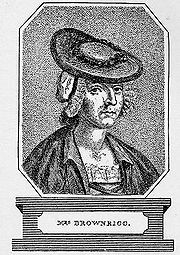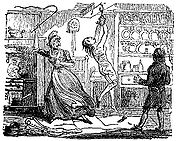
Elizabeth Brownrigg
Encyclopedia

Tyburn
Tyburn is a former village just outside the then boundaries of London that was best known as a place of public execution.Tyburn may also refer to:* Tyburn , river and historical water source in London...
on 14 September 1767.
Early life: 1720–65
Born in 1720 to a working classWorking class
Working class is a term used in the social sciences and in ordinary conversation to describe those employed in lower tier jobs , often extending to those in unemployment or otherwise possessing below-average incomes...
family, Elizabeth married James Brownrigg, an apprentice plumber
Plumber
A plumber is a tradesperson who specializes in installing and maintaining systems used for potable water, sewage, and drainage in plumbing systems. The term dates from ancient times, and is related to the Latin word for lead, "plumbum." A person engaged in fixing metaphorical "leaks" may also be...
, while still a teenager. She gave birth to sixteen children, but only three survived infancy. In 1765, Elizabeth, James and their son John moved to Flower de Luce Road in London's Fetter Lane
Fetter Lane
Fetter Lane is a street in the ward of Farringdon Without in London England. It runs from Fleet Street in the south to Holborn in the north.The earliest mention of the street is "faitereslane" in 1312. The name occurs with several spellings until it settles down about 1612. There is no agreement...
. James was prospering from his career as a plumber, and Elizabeth was a respected midwife
Midwifery
Midwifery is a health care profession in which providers offer care to childbearing women during pregnancy, labour and birth, and during the postpartum period. They also help care for the newborn and assist the mother with breastfeeding....
. As a result of her work, Saint Dunstans Parish appointed her overseer of women and children, and she was given custody of several female children as domestic servants from the London Foundling Hospital
Foundling Hospital
The Foundling Hospital in London, England was founded in 1741 by the philanthropic sea captain Thomas Coram. It was a children's home established for the "education and maintenance of exposed and deserted young children." The word "hospital" was used in a more general sense than it is today, simply...
.
Foundling Hospital: vocational and educational debate
Since Thomas Coram had founded it in 1739, there had been constant debate about what the station of the Foundling Hospital's young charges should be. There was debate over whether they were being overeducated, or whether they should be subject to vocational educationVocational education
Vocational education or vocational education and training is an education that prepares trainees for jobs that are based on manual or practical activities, traditionally non-academic, and totally related to a specific trade, occupation, or vocation...
and trained for apprenticeship
Apprenticeship
Apprenticeship is a system of training a new generation of practitioners of a skill. Apprentices or protégés build their careers from apprenticeships...
s, which would lead to future stable lives as domestic servants.
The latter was decided upon, and the Foundling Hospital began to tender older children and young adolescents for vocational training as apprentices in 1759, shortly before the events described in this entry took place. Elizabeth Brownrigg was not the only abusive adult who used hapless children as virtual slave labour, however, as contemporary accounts indicate. After the events described in this entry, the Foundling Hospital instituted greater safeguards of oversight for apprenticeship tendering, and reported cases of apprentice abuse dropped considerably.
Abuse of servants: 1765–67

Flagellation
Flagellation or flogging is the act of methodically beating or whipping the human body. Specialised implements for it include rods, switches, the cat o' nine tails and the sjambok...
them severely with switches
Switch (rod)
A switch is a flexible rod, typically used for corporal punishment of the birching type, called switching after it, especially when using a single branch: multiple branches are rather called a rod, a less flexible single rod is rather called a cane, an inflexible one a stick; a paddle is broader...
, bullwhip
Bullwhip
A bullwhip is a single-tailed whip, usually made of braided leather, which was originally used as a tool for working with livestock.Bullwhips are pastoral tools, traditionally used to control livestock in open country...
handles and other implements for the slightest infraction of her rules. Mary Jones, one of her earlier charges, ran away from her house and sought sanctuary with the London Foundling Hospital
Foundling Hospital
The Foundling Hospital in London, England was founded in 1741 by the philanthropic sea captain Thomas Coram. It was a children's home established for the "education and maintenance of exposed and deserted young children." The word "hospital" was used in a more general sense than it is today, simply...
. After a medical examination, the Governors of the London Foundling Hospital demanded that James Brownrigg keep his wife's abusive tendencies in check, but enforced no further action.
Heedless of this reprimand, Brownrigg also severely abused two other domestic servants, Mary Mitchell and Mary Clifford. Like Jones before her, Mitchell sought refuge from the abusive behaviour of her employer, but John Brownrigg forced her to return to Flower de Luce Road. Clifford was entrusted to Brownrigg's care, despite the Governors earlier concerns about her abusive behaviour toward her charges. As a result, Brownrigg engaged in more excessive punishment toward Clifford. She was kept naked, forced to sleep on a mat inside a coal hole
Coal hole
A coal hole is a hatch in the pavement above an underground coal bunker. They are sometimes found outside houses that existed during the period when coal was widely used for domestic heating from the early 19th century to the middle 20th century...
, and when she forced open cupboards for food because she was fed only bread and water, Elizabeth Brownrigg repeatedly beat her for a day's duration, chained to a roof beam in her kitchen.
By June 1767 Mitchell and Clifford were experiencing infection of their untreated wounds, and Brownrigg's repeated assaults gave them no time to heal. However, Brownrigg's neighbours were beginning to suspect something was awry within her household, and resultantly, they asked the London Foundling Hospital to further investigate the premises. As a result, Brownrigg yielded Mary Mitchell, but Foundling Hospital Inspector Grundy then demanded to know where Clifford was, and took James Brownrigg prisoner, although Elizabeth and John Brownrigg escaped.
Public feeling ran high against the Brownriggs, ensuring their capture would be swift. In Wandsworth, a chandler recognised the fugitives, and the trio stood trial in the Old Bailey
Old Bailey
The Central Criminal Court in England and Wales, commonly known as the Old Bailey from the street in which it stands, is a court building in central London, one of a number of buildings housing the Crown Court...
in August 1767.
Trial and execution: August–September 1767
By this time, Mary Clifford had succumbed to her infected wounds, and Elizabeth Brownrigg was charged with her murder. At the trial, Mary Mitchell testified against her former employer, as did Grundy and an apprentice of James Brownrigg.Medical evidence and autopsy results indicated that Brownrigg's repeated assaults and negligence of Clifford's injuries had contributed to the fourteen year old's death, so Elizabeth Brownrigg was sentenced to hang at Tyburn and her corpse be publicly dissected. While awaiting execution she expressed remorse and prayed for salvation. Crowds condemned her on the way to her execution, and even sixty years later, the The Newgate Calendar
The Newgate Calendar
The Newgate Calendar, subtitled The Malefactors' Bloody Register, was a popular work of improving literature in the 18th and 19th centuries....
crime periodical still bore testimony to the impression that Elizabeth Brownrigg's crimes had made on Georgian
Georgian era
The Georgian era is a period of British history which takes its name from, and is normally defined as spanning the reigns of, the first four Hanoverian kings of Great Britain : George I, George II, George III and George IV...
and Victorian
Victorian era
The Victorian era of British history was the period of Queen Victoria's reign from 20 June 1837 until her death on 22 January 1901. It was a long period of peace, prosperity, refined sensibilities and national self-confidence...
England. Both the Newgate Calendar and Old Bailey trial records are available online, and are cited below.

